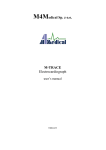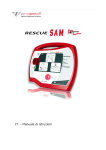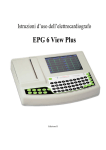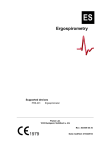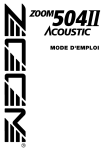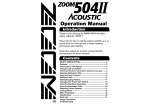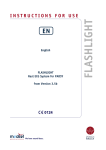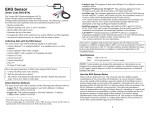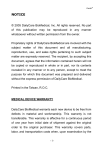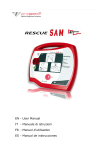Download User's manual
Transcript
User’s manual Edition III – Rev. March 2010 EPG 6 View Plus Electrocardiograph – User’s Manual Edition Date 02 08.02.09 03 27.07.09 Changes Format changes Added CE Declaration of Conformity Improved functionality – added configuration option of AUTO Examination printout Changes in functionality: Import of Examinations from PENDRIVE Preview of Examinations on main display Additional adaptive filter Additional printout formats Different frequencies of isoline filter available Editor DM DM 2 / 25 EPG 6 View Plus Electrocardiograph – User’s Manual Contents CONTENTS 2 INTRODUCTION 4 PRECAUTIONS AND SAFETY INSTRUCTIONS 4 DESCRIPTION 5 INSIDE THE BOX (SUPPLIED ACCESSORIES) 5 OVERVIEW 6 ELECTROCARDIOGRAPH UNIT STEERING TOP PANEL - KEYBOARD FUNCTION KEYS LCD SCREEN TECHNICAL SPECIFICATIONS 6 6 7 7 8 USING THE APPLIANCE 8 FUNCTIONAL ABILITIES PRELIMINARIES PAPER LOADING SETTING UP RECORDING PARAMETERS ARRANGEMENT OF ELECTRODES ENTERING PERSONAL INFORMATION OF THE PATIENT EXAMINATION IN AUTOMATIC MODE EXAMINATION IN MANUAL MODE MAKING THE COPY OF EXAMINATION MANAGING THE MEMORY CONFIGURATION MENU NAVIGATION MAP CLEANING, CONCURRENT DISINFECTION, MAINTENANCE OPERATING AND TRANSPORT ENVIRONMENTAL CONDITIONS 8 9 10 11 12 13 13 14 15 15 17 20 21 21 MANUFACTURER’S DECLARATION OF CONFORMITY FOR THE ELECTROMAGNETIC COMPATIBILITY 22 3 / 25 EPG 6 View Plus Electrocardiograph – User’s Manual Introduction Electrocardiogram is the graphic presentation (ECG diagram) of electrical activity of the heart over time. It allows to examine the mechanism and place where electrical impulses occur. It also enables to check how it works in electrical system and heart muscle and allows to learn its reactions. Indirectly, it allows to examine and diagnose heart muscle behavior, its perfusion, oxidation and tightness. Deviations in ECG record can help to recognize morbid conditions causing invalid heart muscles work, or its reaction to electrical stimulus reducing perfusion and oxidation of that muscle, what causes bad impulses to occur or their incorrect flow. Consider emphasized that ECG is only one of the supplementary examinations which reveals its full potential only with full clinical view of patient’s condition. Some exception can be the myocardial infraction (not always) where the ECG record is evident and unequivocal what enables to make right diagnosis – showing also the exact place in heart muscle area – without seeing the patient. In the rest of heart illness cases ECG seems to be rare authoritative, but it is a vital supplemental examination. EPG 6 VIEW PLUS Electrocardiograph allows to record on thermal paper heart impulses in full range of 12 standard channels. The device is compact. It has small dimensions and a builtin battery. It allows to conduct examinations in all conditions. It is crucial for cardiologic departments as much as for family doctor’s job. Precautions and Safety Instructions All the safety and operating instructions should be read before the appliance is operated. It will help in correct using and servicing of the device making it long-time life and safe tool. It is vital to check periodically the correct work and quality of accessories and device itself. In case of doubts, please contact qualified service personnel. Most vital thing is to instantly pay attention to power cord which should be free from any damage. It will eliminate a risk of electric shock to persons. Using the device simultaneously with cardio stimulators or any other kind of electric stimulators does not expose both patients and personnel to any danger. It is very important not touch neither patient nor any device connected to him during defibrillation. Electrocardiograph can not be used simultaneously with any surgical devices operating on high frequency. To keep ECG record long-time archived, it is needed to make Xerox copy of printouts or print them on outside printer operating on regular copy paper. Thermal paper which is used to work with the device is fragile to environmental factors what can cause the printouts unreadable after some time. The device is not adjusted to work in places where inflammable fumes or combustibles occur. In case of simultaneous connecting the electrocardiograph with other devices to patient, it is necessary to check the risk that may occur of summarizing of leakage currents. Electrocardiograph has CF safety protection type. It allows to do examinations directly on patient’s heart. Always connect electrodes with maximum caution avoiding connectors not touch any metallic parts, including ground. 4 / 25 EPG 6 View Plus Electrocardiograph – User’s Manual Do not attempt to service the appliance yourself as opening or removing covers may expose you to dangerous voltage or other hazards. Refer all servicing to qualified service personnel. Relocating the device between places with extremely different temperature may cause moisture condensation inside. If condensation does occur, neither plug the appliance to the power nor turn it on. Wait a few hours till the unit will have warmed up and any condensation will have evaporated. Description EPG 6 VIEW PLUS electrocardiograph is a sophisticated and modern electronic device. It is dedicated to record ECG impulses in full range of 12 standard channels. Printout is made on thermal paper. The device is equipped with high resolution linear thermal printing unit and color LCD. The built-in battery allows to use it quickly wherever it is necessary. Aesthetic plastic cover together with membrane keyboard makes the device easy to keep clean. Inside the box (supplied accessories) Make sure you have the following accessories: 1. In Box The device – EPG 6 VIEW PLUS electrocardiograph Qty. 1 pc. 2. Clamp electrodes 4 pcs. 3. Sucker electrodes 6 pcs. 4. ECG cord 1 pc. 5. Power cord 1 pc. 6. ECG thermal paper 112mm wide 1 pc. 7. ECG gel 1 pc. 8. User’s manual 1 pc. If some of above accessories are missing please contact your reseller or supplier. MANUFACTURER/DEALER/ASSEMBLER: 0197 PROGETTI S.R.L. 5 / 25 EPG 6 View Plus Electrocardiograph – User’s Manual Overview Electrocardiograph unit paper feeder paper cover release button keyboard power socket USB connectors LCD display electrodes connector Steering top panel - keyboard 6 / 25 EPG 6 View Plus Electrocardiograph – User’s Manual Function keys AUTO Recording – automatic mode START Recording – manual mode STOP Stop recording mm/mV Setting recording sensitivity mm/s Setting recording speed FILTR Setting active filters 3/6/12 Setting the number of leads to be recorded I,II..V6 Setting the group of leads to be recorded MENU Configuration mode Esc Return one level up LCD screen recording speed work mode recording sensitivity leads being recorded active filters Current HR battery charge indicator 7 / 25 EPG 6 View Plus Electrocardiograph – User’s Manual Technical specifications Dimensions (W x H x D) Weight Power Supply Built-in Battery 260 W x 52 H x 220 D mm <1,8kg AC 90-240V, 50-60Hz Li-ion 7,2V, 2,2Ah Can be replaced only by qualified servicing personnel Power Consumption <30VA ECG leads 12 Standard ECG leads: Einthoven’s limb leads I, II, III Goldberger’s limb leads aVR, aVL, aVF Wilson’s precordial leads V1, V2, V3, V4, V5, V6 Sensitivity 2,5/5/10/20 mm/mV 5% Recording Speed 5/10/25/50 mm/s 5% Common Mode Rejection Ratio >100dB Frequency Band 0,05-150Hz Input Impedance >10MΩ Control Range >300 mVpp 10 mVpp Resolution 2,5μV Sampling Frequency 1000Hz Digital Filters 50Hz, 60Hz, 35Hz, 25Hz, antidrift LCD Screen Color graphic display, 320x240 Safety Protection Type CF (EN60601-1) Class I Class / Group Class A / Group 1 (CISPR-11) Operating Environmental Temperature +10 to +40˚C (+50 to +104˚F) Conditions Relative Humidity 25 to 95% (non-condensing) Input circuit is protected against defibrillation impulse. After such impulse, ECG waveform will appear again up to next 10 seconds. Using the appliance Functional abilities Electrocardiograph can record signals from 12-channel standard ECG leads. There are following operating modes available: Automatic recording mode All 12 lead signals are being recorded in one 10 second time block. Afterwards device automatically makes analysis including time and amplitude measurements of P-QRST complex, determining the electrical axis of the heart and the rhythm analysis. Full report printout includes the real ECG waveform, averaged P-QRS-T complex with particular marked waves, conclusions of the measurements and calculations, text ECG interpretation and the data of the patient. Manual recording mode This mode enables users to choose how many lead signals (3, 6 or 12) will be recorded at the same real time. That mode allows to switch between lead groups, change amount of recorded channels, sensitivity and the speed of the recording process during 8 / 25 EPG 6 View Plus Electrocardiograph – User’s Manual the examination. It is also available to activate or deactivate additional ECG signals interferences filters. Copy printout It provides function to make an automatic examination copy printout stored in appliance’s internal memory. The memory can store at least 100 ECG examinations. The printout’s form is similar to the automatic recording mode’s one. Outside printer printout As connected to the electrocardiograph, the outside printer enables to make printouts on regular paper or any media which the particular printer operates on. The only thing required is that the outside printer uses USB port for connection and understands PCL5 script language. Saving examination’s copy to the external USB device (e.g. PenDrive) The data is stored in accordance with the EN1064:2000 standard. Reading copies of examinations from the external USB device (e.g. PenDrive) Extending of ECG examinations’ database with an additional external memory makes it possible to save practically unlimited amount of examinations. Preview of examinations on main display It is possible to preview any stored examinations – from internal or external memory – on main display without printing it out. Preliminaries The appliance is equipped with a built-in battery. To indicate the device turned on press on the keyboard. Before the first turning on or after the long period of not using the device it is necessary to charge the battery. Plug the device in to a power and switch the button on rear side to on position. Constant light of the LED on the keyboard indicates the batteries are being loaded. Blinking of the LED informs that the battery is fully charged and ready to use. 9 / 25 EPG 6 View Plus Electrocardiograph – User’s Manual Paper loading The loading thermal paper in to the built-in printer is very easy. To do it open the paper cover releasing it with button located at the end of papers exit hole (refer to the picture below). Put the roll of the paper in its place in the printer and lead out the end of it outside of the cover. Pay attention to the paper’s direction – head its active (squared) side up. Finish the whole process closing the paper cover. Push it till it’s locked properly in the printing mechanism. Paper cover release button 10 / 25 EPG 6 View Plus Electrocardiograph – User’s Manual Setting up recording parameters Before starting the examination it is needed to set up the required recording parameters. Turning the appliance on automatically recalls parameters last set in the setup menu. If adjusting of some of them is needed it can be done by pressing one of the following keyboard function buttons: mm/mV Setting recording sensitivity Each single push changes the sensitivity value sequentially up: 2,5 → 5 → 10 → 20 mm/mV mm/s Setting recording speed Each single push changes the speed value sequentially up: 5 → 10 → 25 → 50 mm/s FILTR Setting active filters Each single push changes current active filters sequentially: 50 → 35 → 35/50 → 25 → 25/50 Hz → AUTO (Adaptive filter) 3/6/12 Setting the number of leads to be recorded Each single push changes the number of leads to be recorded sequentially up: 3 → 6 → 12 Setting the group of leads to be recorded Available Number of Available groups that can be set. number of leads set to Each single push changes the group groups that be recorded sequentially can be set I,II..V6 3 4 I – II – III ↓ aVR – aVL – aVF ↓ V1 – V2 – V3 ↓ V4 – V5 – V6 6 2 I – II – III – aVR – aVL – aVF ↓ V1 – V2 – V3 – V4 – V5 – V6 12 1 12 Leads Current settings are shown on the LCD screen. 11 / 25 EPG 6 View Plus Electrocardiograph – User’s Manual Arrangement of electrodes The appliance is equipped with 10-electrode wire cable. The standard arrangement: Lead type Lead Connection – body location Red Right arm Einthoven’s Yellow Left arm bipolar limb leads Green Left leg (4 electrodes) Black Right leg (reference point, ground) Strengthened Goldberger’s unipolar limb leads aVR aVL aVF V1 V2 V3 V4 Wilson’s precordial leads V5 V6 To Right arm electrode To Left arm electrode To Left leg electrode placed to the right of the sternum in the fourth (IV) intercostal space placed to the left of the sternum in the fourth (IV) intercostal space placed directly between leads V2 and V4 placed to the left of the sternum in the fifth intercostal (V) space in the midclavicular line (even if the apex beat is displaced) placed to the left of the sternum in the fifth (V) intercostal space, horizontally with V4 in the anterior axillary line placed to the left of the sternum in the fifth (V) intercostal space, horizontally with V4 and V5 in the midaxillary line The appliance constantly monitors the connection status of all the electrodes. In case the electrode does not adhere the skin the diagram is shown in red color in the referring channel. In order to get the proper signals from precordial leads it is vital the limb ones are connected properly. That’s why it is recommended to connect limb leads as first. 12 / 25 EPG 6 View Plus Electrocardiograph – User’s Manual Entering personal information of the patient The appliance allows to add the patient’s personal information to his examination data. To MENU add new information first press then pick ‘PATIENT’. Confirm the selection with Enter . Continuing pick one of the following options: NEW CURRENT STORED To add a new patient To edit the information about the current patient To recall patient’s data stored in electrocardiograph’s memory Entering/Editing form screen Use arrow buttons to navigate between the particular information to be edited. The chosen field is enlighten. Confirm entered data with OK or CANCEL if you want to reject any changes. Examination in automatic mode Automatic mode examination consists in the full 12-lead electrocardiogram recording. All 12 lead signals are being recorded in one 10 second time block. Afterwards device automatically makes analysis including time and amplitude measurements of P-QRS-T complex, determining the electrical axis of the heart and the rhythm analysis. Full report printout includes the real ECG waveform, averaged P-QRS-T complex with particular marked waves, conclusions of the measurements and calculations, text ECG interpretation and the data of the patient. To get proper results in the interpretation it is neccessary to input sex and age of the patient. Otherwise the analysis will set the patient as male 35 years old. Each time the interpretation of ECG signals needs to be validated by a doctor. AUTO The auto mode examination can be initialized by pressing . Before it, operator can determine the printout format. After examination the data can be either printed out or stored in electrocardiograph’s internal memory. The capacity of the memory is at least 100 of complete ECG examinations. 13 / 25 EPG 6 View Plus Electrocardiograph – User’s Manual Schematic representation of normal ECG Part of RR P wave Action Duration Depolarization of atrial muscle 100ms Depolarization of atrioventricular node and atrioventricular PQ segment 50ms bundle Conducting depolarization from sinoatrial node to ventricles’ PQ interval 150ms muscle QRS Complex Depolarization of the ventricles’ muscle 90ms ST segment Slow repolarization of the ventricles’ muscle 120ms T wave Fast repolarization of the ventricles’ muscle 120ms ST interval Slow and fast repolarization of the ventricles’ muscle 280ms QT interval Action potential of ventricles’ muscle 370ms U wave Visible in 50-75% of ECGs RR interval One full heart’s electric cycle 800ms The format of printout of automatic examination can be configured in the MENU: REPORT sub-section of the SETTINGS section. Examination in manual mode This mode enables users to choose how many lead signals (3, 6 or 12) will be recorded at the same real time. That mode allows to switch between lead groups, change amount of recorded channels, sensitivity and the speed of the recording process during the examination. It is also available to activate or deactivate additional ECG signals interferences filters. Every change is indicated on the printout instantly. START The manual mode examination can be initialized by pressing and runs till it is stopped STOP by pressing . 14 / 25 EPG 6 View Plus Electrocardiograph – User’s Manual Making the copy of examination It is possible to print the copy of automatic mode examination. It can be made by pressing MENU Enter followed by picking ‘COPY’ option and confirming it with are the following options to be chosen: PRINT . Afterwards there To print the last examination copy MEMORY PENDRIVE To recall patient’s data stored in electrocardiograph’s memory To save data on the external storage device After MEMORY-READ option is taken please pick up the patient from the list and then choose his particular examination. As confirmed, it will be followed by starting the printing. Just before the printing it is necessary to pick the destination: ROLL To print on the internal thermal printer PRINTER To print on the external A4 USB printer DISPLAY To view on the main screen Before using the ‘PENDRIVE’ option please make sure if the proper device is connected to the electrocardiograph’s USB socket. If so, use the function, then use EXPORT and then pick the patient from the list, his particular examination and after confirming it provide the file name under which it will be saved. In case the file with the same name already exists, it will be overwritten by the new file. The data is stored in accordance with the EN1064:2000 standard. To import an examination form external memory (PenDrive) follow the COPY→PEN DRIVE→IMPORT options. Then pick the ECG file of your interest with an *.SCP extension Enter and press . It makes the file checked in terms of the data is correct and then the examination is copied to the internal memory of the ECG device. The data of the patient is included in the file with the examination. Managing the memory Electrocardiograph is equipped with an internal memory. Its capacity is at least 100 of complete ECG examinations. Storing to the memory is available on two cases – the patient’s area or the ECG examination area. Action How MENU Saving the patient’s data Press then pick PATIENT → MEMORY → SAVE. While saving the copy of an examination, the patient’s personal information is being stored automatically. MENU Deleting the patient’s data Press then pick PATIENT → MEMORY → DELETE. Afterwards pick the particular patient from the list and confirm Enter the choice with . With removing the patient from the memory, all his stored examinations are being deleted too. 15 / 25 EPG 6 View Plus Electrocardiograph – User’s Manual Caution! – This operation cannot be undone! The copy of the examination can be saved after the automatic MENU Saving the examination mode recording is done. First press then pick COPY → MEMORY → SAVE. If there is no previous data of the current patient stored in the memory, it will be stored now. Otherwise the current record will be added to his existing, previously stored data. The patient can be identified by his surname, name and the ID assigned during the first data storing. The particular stored examination can be determined by its date and time. MENU Press then pick COPY → MEMORY → DELETE. The screen should look like this: With the arrow keys [←] [ ↑ ] [ ↓ ] [→] mark the particular Deleting the examination Enter patient on the list and pick him pressing the screen should look like this: . Afterwards, Now, chose from the appeared list the examination to be deleted Enter and confirm with . 16 / 25 EPG 6 View Plus Electrocardiograph – User’s Manual Caution! – The chosen examination is permanently deleted and cannot be undone! Configuration The settings of EPG 6 VIEW PLUS Electrocardiograph configuration are adjustable in wide range. They can be set according the user’s actual needs. Turning the appliance on brings the default initial settings and not adjustable – during the normal using – parameters (e.g. clock time, date, language). MENU To enter the configuration setup press and then pick SETTINGS option. To configure the automatic examination’s report use REPORT option. The REPORT configuration screen will look like this: The following options available in the section Option Description TIME AUTO The duration of ECG examination in automatic mode The most characteristic representative of P-QRS-T will be REPRESENTATIVE shown Text description of examination of electrocardiogram will DIAGNOSTICS be shown All time and amplitude measurements of the representative MEASUREMENT will be shown Sets the printout target. Available are: PRINT Roll – thermal paper USB – external printer connected to the USB port It allows to set the format of the ECG included in the report of the examination. The RECORD option sets the actual format set for manual mode. The rest of the options sets the FORMAT amount of channels and leads groups to be recorded. The following are available: 3x4, 3x4+1, 3x4+2, 6x2, 6x2+1, 12x1. 17 / 25 EPG 6 View Plus Electrocardiograph – User’s Manual To configure the initial settings use INITIAL SETTINGS option. Initial settings can be easily changed during normal using with the navigation keys. The set presets will always appear after each turning on the device. The INITIAL SETTINGS configuration screen should look like this: Using the arrow keys [←] [ ↑ ] [ ↓ ] [→] mark the parameter to be changed and pick it Enter pressing . The available values for it will be shown. Accept the choice with When configuration is finished, confirm it with OK or reject any made changes with CANCEL. The rest of the parameters can be set in CONFIGURATION. Enter . The look of the suitable screen is like this: 18 / 25 EPG 6 View Plus Electrocardiograph – User’s Manual Managing the advanced settings is similar to the presets configuration. The list of available options in the advanced settings section: Option Description MAINS Sets the frequency of the mains – 50Hz or 60Hz Activates or deactivates the antidrift filter. The following frequencies are available: 0,125Hz, 0,25Hz, 0,5Hz and ISOLINE 1,5Hz. If the filter is activated, the producer suggest the 0,25Hz to be set as the most proper one. TIME Sets the real time clock DATE Sets the date Sets the printout format. Available are: FORMAT Standard format Cabrera format QRS Sound indication of the QRS complex detection LANGUAGE Sets the interface language SURGERY Allows to put the name of the consultation’s office 19 / 25 EPG 6 View Plus Electrocardiograph – User’s Manual Menu navigation map MENU PATIENT NEW CURRENT EDIT COPY MEMORY SETUP REPORT INITIAL SETTINGS EDIT EDIT EDIT EDIT EXIT EXIT EXIT EXIT EXIT SAVE READ EXIT DELETE PRINT MEMORY CONFIGRUATION PENDRIVE EXIT PATIENTS LIST EXIT SAVE EXIT READ DELETE PATIENTS LIST EXAMINATIONS LIST EXIT 20 / 25 EPG 6 View Plus Electrocardiograph – User’s Manual Cleaning, concurrent disinfection, maintenance Caution! – Before any cleaning or maintenance unplug the appliance from the wall power outlet! Do not use any abrasive cloths, thinners, alcohol, spray or other chemical solvents. Use only a soft clean cloth – dry or slightly dampened with clean water. It is recommended to do cleaning at least once per month. Upon the heavy-duty usage the cleaning should be done more frequently. All the electrodes should be disinfected after each examination. They need to be subjected to the deproteinization process with a designated liquid, e.g. Sekusept Pulver 2% + activator 0,5%. The electrodes should remain in this bath for at least 30 minutes. Afterwards they need to be washed and dried. Operating and transport environmental conditions Operating Environmental Conditions Surrounding Temperature Relative Humidity Atmospheric pressure + 10 to + +40˚C (+50 to +104˚F) 25 to 95% (non-condensing) 70 to 106 kPa Transport and Storage Environmental Conditions Surrounding Temperature Relative Humidity Atmospheric pressure - 20 to + 60˚C (-4˚F to +140˚F) 25 to 95% (non-condensing) 70 to 106 kPa In every condition the surrounding air should be free from corrosive pollutions. On user’s request the producer can provide the qualified servicing personnel with all the necessary information required to maintain correct repairs and adjusting. 21 / 25 EPG 6 View Plus Electrocardiograph – User’s Manual Manufacturer’s Declaration of Conformity for The Electromagnetic Compatibility Electromagnetic emission tests Tests Conformity CISPR 11 RF Disturbance Group 1 CISPR 11 RF Disturbance IEC 61000-3-2 Harmonic Distortion IEC 61000-3-3 Voltage Fluctuation and Flicker Class A Electromagnetic environment EPG 6 VIEW PLUS Electrocardiograph is the equipment in which there is intentionally generated or used conductively coupled RF energy that is necessary for the internal functioning of the equipment itself. In household rooms the device can be the source of radio distortions. In such case please take appropriate actions. n.a. n.a. Electromagnetic immunity tests Tests IEC 61000-4-2 Electrostatic Discharge IEC 61000-4-4 Electrical Fast Transients IEC 61000-4-5 Surges IEC 61000-4-11 Voltage Dips, Short Interruptions and Voltage Variations IEC 60601 Test level Compatibility level 6kV – Contact Discharge Mode 8kV – Air Discharge Mode Electromagnetic Environment The floor should be wood, concrete, or glazed. If there’s an synthetic lining the relative humidity should be at least 30% 2kV – AC and DC power lines 1kV – I/O lines Typical hospital or commercial environment 1kV – Line to Line 2kV – Line to Ground Typical hospital or commercial environment Voltage test level %Ut Voltage dip %Ut <5 > 95 40 70 <5 60 30 > 95 Duration 0,5 periods 5 periods 25 periods 5 seconds Typical hospital or commercial establishments 22 / 25 EPG 6 View Plus Electrocardiograph – User’s Manual IEC 61000-4-8 Power Frequency Magnetic Fields IEC 61000-4-6 Conducted Disturbances IEC 61000-4-3 Radiated RF Electromagnetic Fields 3A/m 3Vrms 150kHz to 80MHz 3Vrms 80MHz to 2,5GHz Typical hospital or commercial establishments 3V/m Mobile devices 3V/m 23 / 25 EPG 6 View Plus Electrocardiograph – User’s Manual 24 / 25 EPG 6 View Plus Electrocardiograph – User’s Manual Info: PROGETTI S.R.L. Via Bruno Buozzi, 28 10024 Moncalieri – TO – Italy Tel. +39 011 644738 Fax. +39 011 645822 [email protected] www.progettimedical.com 25 / 25

























